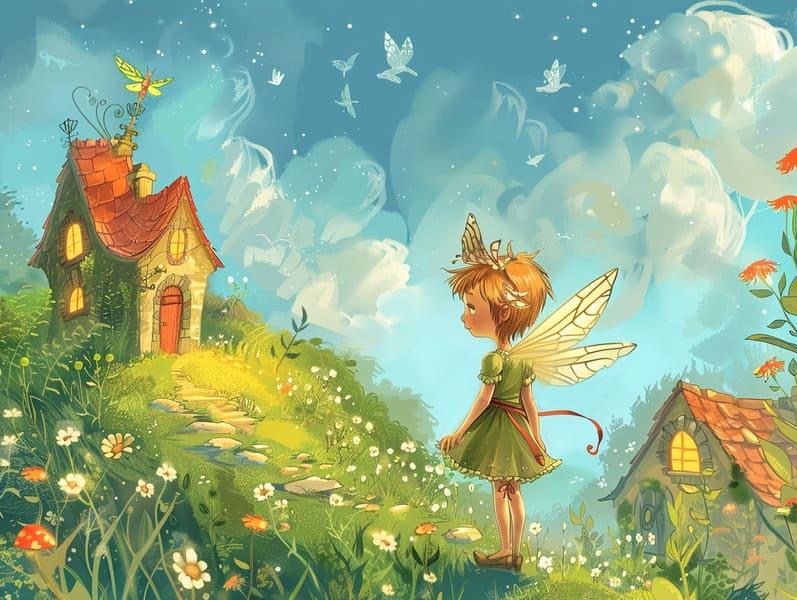
Best fairy tales have old origins. These tales have been shared from one generation to the next far before they were ever written down. They came from a variety of cultures, including American traditions. They were initially shared among older generations, often carrying themes and messages mirroring the societal norms and beliefs of the time.
The Brothers Grimm, Jacob and Wilhelm, were among the first to assemble many of these beloved tales. Their anthology, "Grimm's Fairy Stories," included stories like "Ashenputtel," "Hansel and Grethel," and "Snow White," which have since become pillars in the world of iconic fairy tales. Similarly, Hans Andersen's fantastical fairy tales, such as "The Little Mermaid," and "The Little Duckling," have touched hearts worldwide, solidifying their place in the pantheon of classic fairy tales.
Though they are old, these stories remain as meaningful as ever, especially as bedtime stories for kids. These magical stories are now available in diverse formats, including colorful picture books, delightful animations, and internet fairy tales.
Their lasting presence can be ascribed to several enchanting factors:
Significant Morals: Ancient fairy tales often teach important moral lessons. Fairy tales like "The Story of the Boy Who Cried Wolf" teach the importance of truthfulness, while "The Race of the Tortoise and the Hare" exemplify the qualities of resolve and meekness. These tales offer little ones clear distinctions between ethical and unethical, shaping their moral compass in a soft yet meaningful way.
Empathy and Understanding: Fairy tales frequently present figures facing tests and troubles, inciting children to empathize with their struggles and champion their triumphs. For instance, "Beauty's Beast" highlights the necessity of seeing beyond looks to know the real character of a individual, cultivating sympathy and awareness.
Cultural Insights: Many timeless fairy tales are imbued with the cultural contexts from which they emerged. Reading these tales can provide illuminating insights into different societies, promoting a sense of cultural insight and respect.
Imagination and Creativity: The fanciful elements in timeless fairy tales—talking beasts—trigger children’s creativity. These stories bring readers to enchanted realms, stimulating innovative ideas and a sense of awe that continues a lifetime.
Timeless fairy tales are not only captivating but also pedagogical. They function as captivating tools in building various mind and heart abilities in young ones. When fairy tales are told out loud, they improve communication skills by introducing new terms and sophisticated sentence structures. This practice also boosts listening abilities and mental focus, as children concentrate deeply, ready to see what happens next.
Furthermore, deliberating the themes and characters of traditional fairy tales can promote thinking skills and thinking skills. Children are instructed to notice patterns, guess what will happen, and figure out cause and effect. These reflections also further the young reveal their thoughts and feelings, strengthening their emotional intelligence.
In today’s digital era, the accessibility of these guys online storybooks has made these narratives more available than ever. Websites and applications share broad selections of famous fairy tales that can be seen or played anytime, anywhere. Fairy tales read aloud are particularly liked, featuring an delightful method for young ones to experience these delightful tales. Audio stories and read-to-me videos transport characters and settings to life, often paired with fantastical melodies and musical scores that raise the narrative experience.
The unending appeal of timeless fairy tales lies in their ability to change to present eras while continuing with their key morals. Contemporary reimaginings of these tales often showcase more diverse protagonists and modern settings, making them accessible to today’s audience. However, the fundamental themes of courage, compassion, and equity remain unchanged, continuing to move children of all ages.
Traditional fairy tales also offer a sense of security and closeness. They introduce a structured narrative with a recognizable beginning, middle, and end, often finishing with the termination of conflicts and the triumph of morality over wickedness. This constancy can be solacing for young ones, extending a sense of dependability in an variable world.
Ancient fairy tales continue to bewitch and train new generations, maintaining their mystique and meaningfulness in modern society. As children's night stories, they furnish a perfect blend of charm and enlightenment, encouraging moral values, empathy, and creativity. The prevalence of digital storybooks and the likability of fairy tales read out loud assure that these timeless fairy tales remain accessible to new generations.
By safeguarding and imparting these stories, we continue to extol the rich tapestry of inventiveness and cultural heritage. Whether you are perusing a vibrantly illustrated book, exploring a digital library, or listening on an read-aloud story, the delight of children's fairy tales is always within reach. These narratives illustrate of the unchanging nature of fairy tales and its ability to hold us together across time and space.
Even if you are perusing a gorgeously illustrated book, experiencing a cyber collection, or listening via an narrated book, the charm of popular fairy tales is always within reach.
These fairy tales demonstrate of the unwavering magic of narratives and its ability to unite us across generations and cultures, forming a connection that captivates and teaches alike.